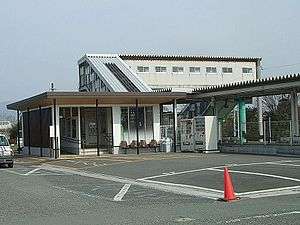Namazuta Station
Namazuta Station (鯰田駅, Namazuta-eki) is a railway station on the Chikuhō Main Line operated by JR Kyushu in Iizuka, Fukuoka Prefecture, Japan.[1][2]
Namazuta Station 鯰田駅 | |
|---|---|
 Namazuta Station in 2014 | |
| Location | Japan |
| Coordinates | 33°40′08″N 130°42′07″E |
| Operated by | |
| Line(s) | ■ Chikuhō Main Line |
| Distance | 34.7 km from Wakamatsu |
| Platforms | 2 side platforms |
| Tracks | 2 |
| Construction | |
| Structure type | At grade |
| Parking | Available |
| Bicycle facilities | Bike shed |
| Other information | |
| Status | Unstaffed |
| Website | Official website |
| History | |
| Opened | 13 August 1891 |
| Traffic | |
| Passengers (FY2016) | 389 daily |
| Rank | 274th (among JR Kyushu stations) |
| Location | |
 Namazuta Station Location within Japan | |
Lines
The station is served by the Chikuhō Main Line and is located 34.7 km from the starting point of the line at Wakamatsu.[3]
Station layout
The station, which is unstaffed, consists of two staggered side platforms serving two tracks. A station building of modern concrete design houses a waiting room and an automatic ticket vending machine. There is a ramp up to the station building entrance from the access road but access to the opposite side platform is by means of a sheltered footbridge. A bike shed and parking lots for cars are provided outside the station.[2][3]
 A view of the station platforms and tracks.
A view of the station platforms and tracks. The old station building, as seen in 2009.
The old station building, as seen in 2009.
History
The privately run Chikuho Kogyo Railway had opened a track from Wakamatsu to Nōgata on 30 August 1891 and by 28 October 1892, this had been extended southwards to Kotake. In the next phase of expansion, the track was further extended, with Iizuka becoming new southern terminus on 3 July 1893. On the same day, Namazuta was opened as an intermediate station on this new stretch of track. On 1 October 1897, the Chikuho Kogyo Railway, now renamed the Chikuho Railway, merged with the Kyushu Railway. After the Kyushu Railway was nationalized on 1 July 1907, Japanese Government Railways (JGR) took over control of the station. On 12 October 1909, the station became part of the Chikuho Main Line. With the privatization of Japanese National Railways (JNR), the successor of JGR, on 1 April 1987, control of the station passed to JR Kyushu.[4][5]
Passenger statistics
In fiscal 2016, the station was used by an average of 389 passengers daily (boarding passengers only), and it ranked 274th among the busiest stations of JR Kyushu.[6]
References
- "JR Kyushu Route Map" (PDF). JR Kyushu. Retrieved 3 March 2018.
- "鯰田駅" [Namazuta]. hacchi-no-he.net. Retrieved 9 March 2018.
- Kawashima, Ryōzō (2013). 図説: 日本の鉄道 四国・九州ライン 全線・全駅・全配線・第3巻 北九州 筑豊 エリア [Japan Railways Illustrated. Shikoku and Kyushu. All lines, all stations, all track layouts. Volume 3 Kyushu Chikuhō area] (in Japanese). Kodansha. pp. 38, 74. ISBN 9784062951623.
- Ishino, Tetsu; et al., eds. (1998). 停車場変遷大事典 国鉄・JR編 [Station Transition Directory - JNR/JR] (in Japanese). I. Tokyo: JTB Corporation. p. 233. ISBN 4533029809.
- Ishino, Tetsu; et al., eds. (1998). 停車場変遷大事典 国鉄・JR編 [Station Transition Directory - JNR/JR] (in Japanese). II. Tokyo: JTB Corporation. p. 787. ISBN 4533029809.
- "駅別乗車人員上位300駅(平成28年度)" [Passengers embarking by station - Top 300 stations (Fiscal 2016)] (PDF). JR Kyushu. 31 July 2017. Archived from the original (PDF) on 1 August 2017. Retrieved 3 March 2018.
| Wikimedia Commons has media related to Namazuta Station. |